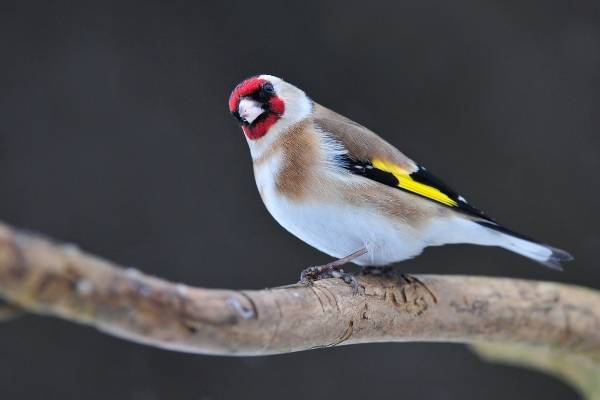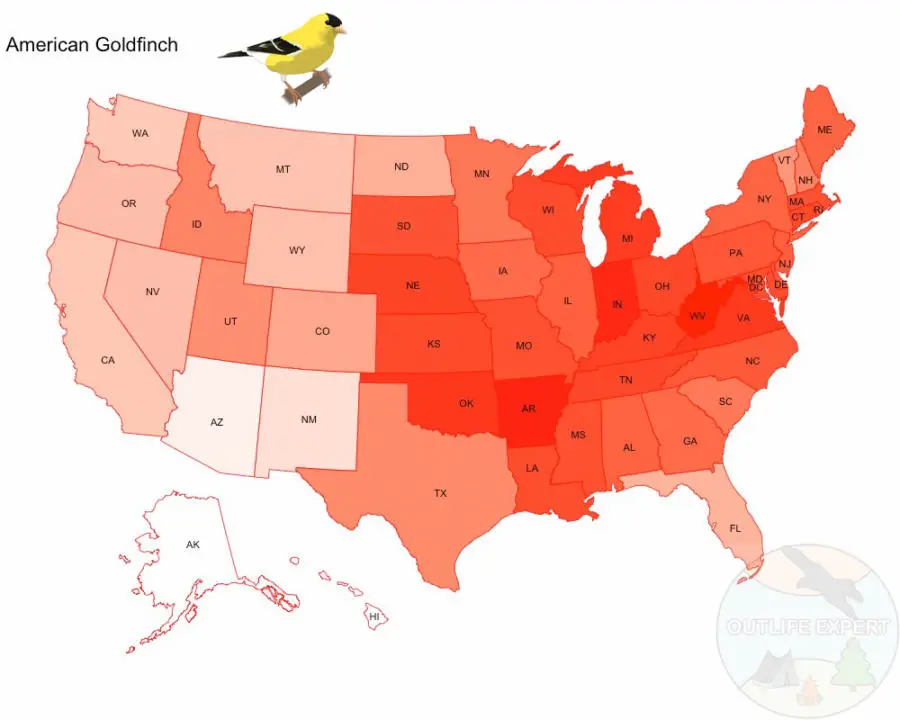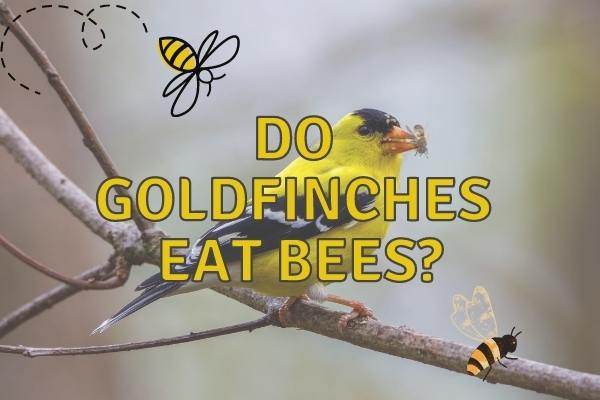The American goldfinch is a small garden bird commonly found in large flocks throughout the US, southern Canada, and central Mexico. Their natural habitat is open meadows, but they often flock to bird feeders in suburban areas.
Even though American goldfinches do occasionally eat smaller insects such as aphids and ants, goldfinches do not eat bees because they are too fast for them to catch and too dangerous to swallow.
Bees and wasps are not eaten by most smaller birds as they are relatively fast, heavy, and large insects that are not easy to catch.
There is also the important danger that they may sting the bird upon ingestion – even when the bee is dead! Therefore most birds avoid bees altogether.
Most birds, including finches, do know the danger of bees and consciously avoid the striped color pattern on the back of bees and wasps.
However, a few bird species, however, are able to safely eat bees because they are fast enough to catch them and skilled enough to separate the stinger from the body before ingestion.
Goldfinches are primarily seed eaters and their beak, typical for finches, is designed to crush and peel apart hard seeds rather than hunting for insects.
However, when foraging, goldfinches will often encounter insects such as aphids, flies, worms and ants that they will sometimes eat.
An exception from their strictly herbivorous diet is when feeding their young. Baby goldfinches mostly eat insects because they cannot easily digest seeds and the goldfinch parents will therefore predominantly bring them soft insects such as larvae and worms.
Contents
American Goldfinch – Bird Facts!

American Goldfinch summary:
Family: Fringillidae
Occurrence: Southern Canada to California in the summer. Also Florida and Mexico in winter.
The American goldfinch belongs to the Fringillidae (finch) family. There are four subspecies: the eastern goldfinch, the pale goldfinch, the northwestern goldfinch, and the willow goldfinch.
Other closely related species include the lesser goldfinch, Lawrence’s goldfinch, and the siskins. Despite the similar sounding name, they are not related to the European goldfinch.
Diet of Goldfinches
The American goldfinch’s diet consists entirely of seeds. Their breeding season starts in June, when seeds are in greatest supply. Monogamous pairs nest in trees or shrubs.
Their nest is an open cup of three inches, woven from plant fibers, bound by spiderwebs and caterpillar silk, and lined with plant down. They will lay four to six eggs, each less than an inch long, pale bluish white, with occasional brown spots.
Diet in the wild: Mostly seeds and smaller insects.
Feeder food preferences:
- Black Oil Sunflower Seeds
- Hulled Sunflower Seeds
- Nyjer (Thistle) seeds
- Cracked corn or peanuts
- Millet
What Feeder Type do Goldfinches Prefer?
Goldfinches prefer small and large seed feeders, which makes it possible for them to sit on. If you want to attract goldfinches more specifically, you should go for feeders high above ground with small holes and harder seeds.
- Large tube feeder
- Small tube feeder
- Ground feeder
- Large hopper feeder
- Small hopper feeder
- Platform feeder
Identifying the American goldfinch
The American goldfinch is a 4 to 6-inch, brown to yellow bird with a white undertail. Their wings and tail are black with white markings. In summer, the male is easily distinguishable with his bright yellow plumage and black cap.
The female has a pale-yellow underside in the summer months with an olive-colored head and back. In winter, both males and females are olive-brown with a yellowish head. Juveniles are a dull brown with pale yellow undersides. Their call is a chirpy “tsee-tsi-tsi-tsit”.
Subspecies can be distinguished by their distribution and small variations in coloration and size. The eastern goldfinch is the most common and most eastern subspecies.
They occur from Colorado eastwards from southern Canada to central Mexico.
The slightly larger pale goldfinch, as its name suggests, has a paler body, stronger white markings, and a larger black cap in the male. They have a more western range stretching from British Columbia to western Ontario south to Mexico.
The northwestern goldfinch is darker and smaller compared to the other subspecies. They occur along the coastal slope of the Cascade Mountains from southern British Columbia to central California.
The willow goldfinch has a browner winter plumage, and in summer, males have a smaller black cap. They are found to the west of the Sierra Nevada range in California southwards into Baja California.
The male lesser goldfinch could be confused with the male American goldfinch but their cheeks and back are olive to black instead of yellow and the black crown of the male covers its entire head. In both males and females, the lesser goldfinch has a yellow undertail, instead of white.
The Lawrence’s goldfinch male has a black face and yellow breast, but the rest of its body is grey. Females of Lawrence’s goldfinch have a grey head and back, whereas the American goldfinch has a yellow head and olive back.
Biology
The American goldfinch’s diet consists entirely of seeds. Their breeding season starts in June, when seeds are in the greatest supply. Monogamous pairs nest in trees or shrubs.
Their nest is an open cup of three inches, woven from plant fibers, bound by spiderwebs and caterpillar silk, and lined with plant down.
They will lay four to six eggs, each less than an inch long, pale bluish-white, with occasional brown spots.
Attracting the American goldfinch to your backyard
To attract the American goldfinch, you can put out various seeds (especially sunflower and nyjer seeds), and beet greens. Use a feeder designed for smaller birds, because large birds at the feeder could discourage the American goldfinch.
During the breeding season, you can put out 100% cotton for them as nesting material. Plant indigenous grasses, sunflowers, thistles, dandelions, coneflowers, milkweed, zinnias, and large trees in your garden. A bird bath or water feature would provide an additional attraction.
Is the American Goldfinch endangered?
The American goldfinch is listed as a least concern species since its population is generally increasing across the United States.
However, climate change could cause southern contractions in their distribution with local extinctions in various states, due to the increased risks of heatwaves and heavy rainfall endangering their eggs and chicks.

The stronger the red color, the higher the chance that you will see the American goldfinch in your backyard.
Conclusion
The American goldfinch is a small garden bird commonly found in large flocks throughout the US, southern Canada, and central Mexico.
Their natural habitat is open meadows, but they often flock towards bird feeders in suburban areas.
Even though American goldfinches do occasionally eat smaller insects such as aphids and ants, goldfinches do not eat bees because they are too fast for them to catch and too dangerous to swallow.
Bees and wasps are not eaten by most smaller birds as they are relatively fast, heavy and large insects that are not easy to catch.
Goldfinches are primarily seed-eaters and their beak, typical for finches, is designed to crush and peel apart hard seeds rather than hunting for insects.
Most birds, including finches, do know the danger of bees and consciously avoid the striped color pattern on the back of bees and wasps.
However, a few bird species are able to safely eat bees because they are fast enough to catch them and skilled enough to separate the stinger from the body before ingestion. These include the “Bee eaters” shown in the video on this page.




